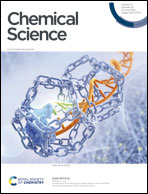Rationally designed Ru(ii)-metallacycle chemo-phototheranostic that emits beyond 1000 nm†
Abstract
Ruthenium complexes are emerging as potential complements to platinum drugs. They also show promise as photo-diagnostic and therapeutic agents. However, most ruthenium species studied to date as potential drugs are characterized by short excitation/emission wavelengths. This limits their applicability for deep-tissue fluorescence imaging and light-based therapeutic treatments. Here, we report a Ru(II) metallacycle (Ru1100) that emits at ≥1000 nm. This system possesses excellent deep-tissue penetration capability (∼7 mm) and displays good chemo-phototherapeutic performance. In vitro studies revealed that Ru1100 benefits from good cellular uptake and produces a strong anticancer response against several cancer cell lines, including a cisplatin-resistant A549 cell line (IC50 = 1.6 μM vs. 51.4 μM for cisplatin). On the basis of in vitro studies, it is concluded that Ru1100 exerts its anticancer action by regulating cell cycle progression and triggering cancer cell apoptosis. In vivo studies involving the use of a nanoparticle formulation served to confirm that Ru1100 allows for high-performance NIR-II fluorescence imaging-guided precise chemo-phototherapy in the case of A549 tumour mouse xenografts with no obvious side effects. This work thus provides a paradigm for the development of long-wavelength emissive supramolecular theranostic agents based on ruthenium.



 Please wait while we load your content...
Please wait while we load your content...